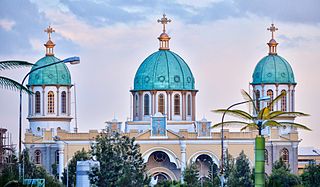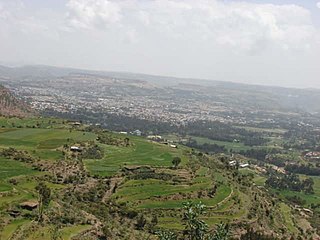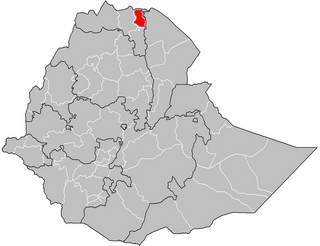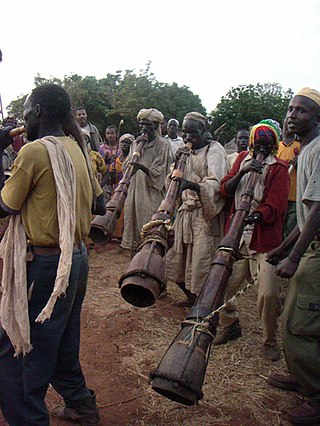
Sources disagree as to the current population of Eritrea, with some proposing numbers as low as 3.6 million and others as high as 6.7 million. Eritrea has never conducted an official government census.

The music of Eritrea, is a diverse mix of traditional and popular styles originating from ancient to modern times. The nine major ethnic groups of Eritrea—Afar, Bilen, Hedareb, Kunama, Nara, Rashaida, Saho, Tigre and Tigrinya—celebrate autonomous music-making expressed through a rich heritage of vocalists, instrumentalists and activities within the country and throughout the international diaspora. The country's music is informed by a range of ethnolinguistic group dynamics in the region, by its shared pre-colonial history with and revolutionized independence from Ethiopia, and by its exposure to globalized American music in the mid-twentieth century.
The Saho language is an Afro-Asiatic language spoken in Eritrea, Sudan and Ethiopia. It belongs to the family's Cushitic branch.

The Culture of Africa is varied and manifold, consisting of a mixture of countries with various tribes depicting their unique characteristic and trait from the continent of Africa. It is a product of the diverse populations that inhabit the continent of Africa and the African diaspora. Generally, Culture can be defined as a collective mass of distinctive qualities belonging to a certain group of people. These qualities include laws, morals, beliefs, knowledge, art, customs, and any other attributes belonging to a member of that society. Culture is the way of life of a group of people.

Eritrean cuisine is based on Eritrea's native culinary traditions, but also arises from social interchanges with other regions. The local cuisine, despite featuring influences of both the Ottoman and Italian cuisines, shares similarities with the cuisine of neighboring Ethiopia and the cuisines from other African countries in the region.

Ethiopia is one of the few countries with so many traditional aspects and cultural mannerism. the country that is located in the horn of Africa has many traditions and cultures that is experienced in the daily livelihood of the people, starting of having their own calendar to the food, clothing, music and cuisine.
Habesha peoples is an ethnic or pan-ethnic identifier that has been historically employed to refer to Semitic-speaking and predominantly Oriental Orthodox Christian peoples found in the highlands of Ethiopia and Eritrea between Asmara and Addis Ababa and this usage remains common today. The term is also used in varying degrees of inclusion and exclusion of other groups.

The Afar, also known as the Danakil, Adali and Odali, are a Cushitic ethnic group inhabiting the Horn of Africa. They primarily live in the Afar Region of Ethiopia and in northern Djibouti, as well as the entire southern coast of Eritrea. The Afar speak the Afar language, which is part of the Cushitic branch of the Afroasiatic family. Afars are the only inhabitants of the Horn of Africa whose traditional territories border both the Red Sea and the Gulf of Aden.

Sabagadis Woldu was a governor of Tigray Province of the Ethiopian Empire from 1822 to 1831. Sabagadis gained some notoriety in the first decade of the 19th century for rebelling a number of times against his overlord, Ras Wolde Selassie. But just before the death of Wolde Selassie it seems that he made up with his master and became one of his loyal lieutenants. Following Wolde Selassie's death in 1816, he defied the authority of Wolde Selassie's son, and became the most powerful warlord in Tigray. Making Adigrat his capital, he ruled Tigray and a small strip of the coastal plains of Eritrea by 1818. His rule also extended to the Eritrean highlands.

Agame was a former province in northern Ethiopia. It includes the northeastern corner of the Ethiopian Empire, borders in Eritrea, Tembien, Kalatta Awlalo and Enderta in the south, and both the Eritrean and Ethiopian Afar lowlands in the east. This relative location of Agame is at the strategic crossroads between the Red Sea and the northern Tigrayan plateau on the other. In pre-1991, Agame had a total area of about 4,889 square kilometres (1,888 sq mi) with an estimated population of 344,800.

Tigray Province, also known as Tigre, was a historical province of northern Ethiopia that overlayed the present day Afar and Tigray regions. Akele Guzai borders with the Tigray province. It encompassed most of the territories of Tigrinya-speakers in Ethiopia. Tigray was separated from the northern Tigrinya speaking territories by the Mareb River, now serving as the state border to Eritrea, bordering Amhara region in the south.

The Saho are a Cushitic ethnic group who inhabit large sections of Eritrea and northern Ethiopia. They speak Saho as a mother tongue.

Tigrayans are a Semitic-speaking ethnic group indigenous to the Tigray Region of northern Ethiopia. They speak the Tigrinya language, an Afroasiatic language belonging to the Ethiopian Semitic branch.

The culture of Eritrea is the collective cultural heritage of the various populations native to Eritrea. Eritrea has nine recognized ethnic groups. Each group have their own unique traditions and customs but some traditions are shared and appreciated among different ethnic groups. The local culture consists of various, and often quite similar, traditions practiced by the nation's many Cushitic and Ethiopian Semitic-speaking Afro-Asiatic ethnic groups, in addition to those practiced by the area's Nilotic minorities. Eritrean culture is in some ways similar to the cultures of other countries in the region.

The Eastern Zone is a zone in the Tigray Region of Ethiopia. It is bordered on the east by the Afar Region, on the south by the South Eastern Zone, on the west by the Central Zone and on the north by Eritrea. Its highest point is Mount Asimba. Towns and cities in the Eastern Zone include Adigrat, Atsbi, Hawzen, and Wukro.

Irob is a district or woreda in the Tigray Region of Ethiopia. This woreda is named after the Irob people, who are the predominant ethnic group living there. Located in the Misraqawi Zone at the eastern escarpment of the Ethiopian highlands, Irob is bordered on the south by Saesi Tsaedaemba, on the west by Gulomahda, on the north and east by the Endelli River which separates it from Eritrea, and on the southeast by the Afar Region. The administrative center of this woreda is Dawhan; other towns include Alitena, the former administrative center.
The provinces of Eritrea existed since pre-Axumite times and became administrative provinces from Eritrea's incorporation as a colony of Italy until the conversion of the provinces into administrative regions. Many of the provinces had their own local laws since the 13th century.

Eritreans are the native inhabitants of Eritrea, as well as the global diaspora of Eritrea. Eritreans constitute several component ethnic groups, some of which are related to ethnic groups that make up the Ethiopian people in neighboring Ethiopia and people groups in other parts of the Horn of Africa. Nine of these component ethnic groups are officially recognized by the Government of Eritrea.

The Berta (Bertha) or Funj or Benishangul are an ethnic group living along the border of Sudan and Ethiopia. They speak a Nilo-Saharan language that is not related to those of their Nilo-Saharan neighbors. The total population of Ethiopian-Bertas in Ethiopia is 208,759 people. Sudanese-Bertas number around 180,000.
Sondina is a village in the Bassar Prefecture in the Kara Region of north-western Togo, a West African country known for its rich cultural heritage and diverse landscapes. Situated in the Kara Region, Sondina has a unique history, cultural identity, and plays a significant role in the local tapestry of Togo.













